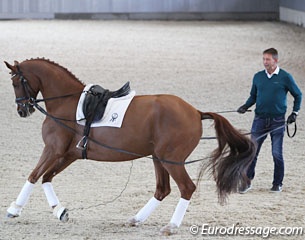
The first day of the 2016 Global Dressage Forum continued with several practical demonstrations. Former show jumping champion Franke Sloothaak worked a young dressage horse on the double lunge line with the afternoon session became a celebration of structured youth programs to guarantee the future of dressage sport.
Double Lunge Line Work with Franke Sloothaak
Upon popular request Franke Sloothaak returned to the Global Dressage Forum. In 2007 he did a double demo with Kyra Kyrklund on training young horses across the disciplines and this year he showed how he works his horses on the double lunge line. Sloothaak called it "alternative training" of sport horses because "so much more is possible if we work correctly with the horses."
Paul Stecken's words of "Richtig reiten reicht" reverberated through Sloothaak's session in which the fair, correct and diversified training of a horse will bring the best out of the horse. "I am the horse's manager and make them able to win," said the born Dutchman. "I always have one bad period with the horse, always at the start. It's like beginning with gymnastics. Our body is not prepared for it; it's a hard part for the pody. You have to give the horse the time to get his body ready for the work." Sloothaak emphasized that before saddle breaking a young horse, it is highly beneficial to already start working them very lightly on the lunge line, so they build some muscles before they side reins, saddle and rider are thrown on.
Sloothaak stated that it takes a green horse at least three months to obtain the same balance under saddle as he has jumping in freedom. Franke trains with the double lunge line as a tool for gymnastics as well as diversification in the training. "It's nice with a young horse, to go out in the field, to go cross country, to play with the young horse," he said. "But you always have to stop when you have a good feeling and then he will want to give it to you again and again." Don't overpush was a clear statement the former World Champion reiterated throughout.
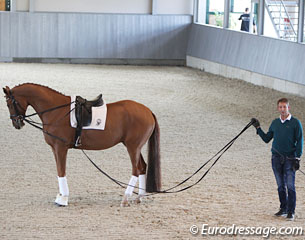 Sloothaak demonstrated his version of double lunge work on Hof Kasselmann's 6-year old chestnut Dolby Surround (by Der Designer) with whome he had worked only three times before the Forum. The sharp chestnut reacted quickly to the clicking of Franke's voice and easily showed half steps. Franke had the horse trotting and cantering circles and used the straight lines to get behind the horse and switch lead. "I slow him down to get more activity from behind, so he takes shorter, quicker steps. One side is always a bit more difficult, usually the right side and that is also why this horse is bent more to the outside on the right lead," Franke explained. "Not many people take enough care of the stomach muscles. Strong, stiff backs often come from weaknesses in the stomach muscles."
Sloothaak demonstrated his version of double lunge work on Hof Kasselmann's 6-year old chestnut Dolby Surround (by Der Designer) with whome he had worked only three times before the Forum. The sharp chestnut reacted quickly to the clicking of Franke's voice and easily showed half steps. Franke had the horse trotting and cantering circles and used the straight lines to get behind the horse and switch lead. "I slow him down to get more activity from behind, so he takes shorter, quicker steps. One side is always a bit more difficult, usually the right side and that is also why this horse is bent more to the outside on the right lead," Franke explained. "Not many people take enough care of the stomach muscles. Strong, stiff backs often come from weaknesses in the stomach muscles."
The jumping rider kept stressing that the horse needs regular breaks when it was doing something good. "When it's good, give him time to relax. Give the horse a good feeling," said Sloothaak. "Listen to the horse, the horse will tell you (when to stop)." Many riders overask their horses and break them at an early point in their career, because talented horses give them a good feeling and the ambitious rider wants more, wants it even better, more spectacular, more expressive. "In Holland we say don't kill the cow you live from," said the level-headed Sloothaak, who is one of those talented riders that proclaiming a proper sense of horsemanship not always seen at top level.
Young Talent Gradually Guided to the Top
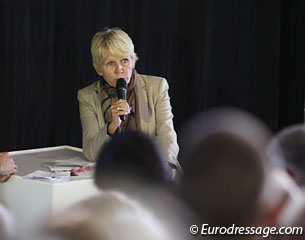 The final afternoon session on the first day of the Forum was moderated by German 5* judge Katrina Wüst who contributed significantly to the development of the children and pony tests. Sven Rothenberger concluded the session with a short talk on how he managed his three children to the absolute top in Europe.
The final afternoon session on the first day of the Forum was moderated by German 5* judge Katrina Wüst who contributed significantly to the development of the children and pony tests. Sven Rothenberger concluded the session with a short talk on how he managed his three children to the absolute top in Europe.
Five highly decorated youth riders - Children's rider Ekaterina Aristova (2016 European Children's team gold medal winner), pony rider Lucie Anouk Baumgurtel (2016 European Pony Champion), junior rider Lina Uzunhasan (5th at the 2016 European Junior Championships), young rider Jeanine Nieuwenhuis (2016 European Young Riders Champion) and Under 25 rider Diana Porsche (3rd at the 2016 European U25 Championships) - appeared at the Forum giving in a 20-minute demo in which they showed the difficult movements of their levels while being coached by their trainers, respectively Heike Osterkamp, Connie Endres, Anky van Grunsven, Tineke Bartels, and Leida Collins-Strijk.
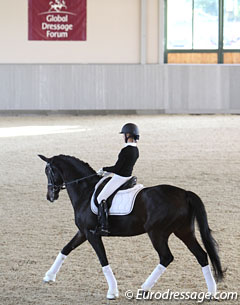 The development of the Children's division is an excellent example of how competitive dressage sport can be made more accessible in countries where pony sport is absent. The fact that Russia won team and individual gold at the 2016 European Championships is testimony to that. "For children who are tall, they can start on horses instead of ponies and they can grow from one level to another on the same horse," Wüst explained. The division is not very much ingrained in Germany, Holland, Denmark and Great Britain, for instance, where starting on ponies is the norm. However, for developing dressage nations in which pony sport is not big, the Children's division is an excellent stepping stone to bring young children to a competive level internationally. It is nice that the leading European dressage nations are refraining from sending teams to the Europeans to give the other countries more opportunity to shine.
The development of the Children's division is an excellent example of how competitive dressage sport can be made more accessible in countries where pony sport is absent. The fact that Russia won team and individual gold at the 2016 European Championships is testimony to that. "For children who are tall, they can start on horses instead of ponies and they can grow from one level to another on the same horse," Wüst explained. The division is not very much ingrained in Germany, Holland, Denmark and Great Britain, for instance, where starting on ponies is the norm. However, for developing dressage nations in which pony sport is not big, the Children's division is an excellent stepping stone to bring young children to a competive level internationally. It is nice that the leading European dressage nations are refraining from sending teams to the Europeans to give the other countries more opportunity to shine.
German pony team trainer Connie Endres stressed the importance of the youth divisions: The youth riders tests are "focused to improve the riding skills of the children. To learn good riding is the most important thing. The Olympic future are of course brilliant horses and very good riders," said Endres.
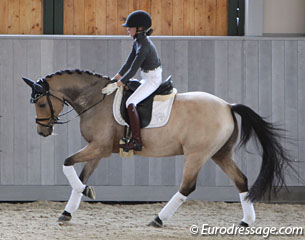 Switching from ponies to horses poses many challenges for young riders. Anky van Grunsven stated that many juniors struggle with the flying change. "Good timing for the change is difficult for the juniors. They have to show their skills and their feeling for collection at this level," she said. Anky also said that she does not like her riders to practise the tests too much as the horse will remember the floorplan. "The horse remembers the test. it's important that the horses are not brain washed to know the test. They have to wait for the aids," she added. She also prefers that once the rider switches to the double bridle, the horse is ridden in it the majority of the time. "The switching around is confusing," she stated. "If you are good with two reins, they don't have problems with four reins. We always make sure the curb rein is quite loose."
Switching from ponies to horses poses many challenges for young riders. Anky van Grunsven stated that many juniors struggle with the flying change. "Good timing for the change is difficult for the juniors. They have to show their skills and their feeling for collection at this level," she said. Anky also said that she does not like her riders to practise the tests too much as the horse will remember the floorplan. "The horse remembers the test. it's important that the horses are not brain washed to know the test. They have to wait for the aids," she added. She also prefers that once the rider switches to the double bridle, the horse is ridden in it the majority of the time. "The switching around is confusing," she stated. "If you are good with two reins, they don't have problems with four reins. We always make sure the curb rein is quite loose."
Tineke Bartels' European young rider champion Jeanine Nieuwenhuis rode her winning kur to music aboard her gold medal horse Athene, a very powerful Dutch warmblood who has super powerful and expressive gaits, but who appeared strong in the mouth with a retracted tongue. Nieuwenhuis rode her freestyle, adapted to a 20 x 40 m arena, and impressed with her fantastic, creative and balanced choreography. Diana Porsche loved showing off the unlimited piaffe-passage talent of her wonderful Di Sandro, a super Grand Prix schoolmaster discovered for her by her previous trainer Dieter Laugks. Porsche's coach Leida Strijk explained that riders lean by trial and error. "If you don't make a mistake, you will not learn. You have to try how far you can go and what the maximum is," she said about training at home in preparation of a competition.
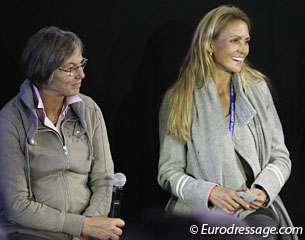 While this one-hour-and-a-half display of some of Europe's best European youth riders was very impressive, the relevance to the 2016 GDF programme was unclear. Instead it would have been better that the riding times had been shortened and more time was freed for discussion. A debate on how to better implement pony/children sport in all countries, how to improve pony breeding all over the continent or how youth riders programmes could be incorporated by national equestrian federations across Europe to improve the transition to Under 25 level would have made more sense.
While this one-hour-and-a-half display of some of Europe's best European youth riders was very impressive, the relevance to the 2016 GDF programme was unclear. Instead it would have been better that the riding times had been shortened and more time was freed for discussion. A debate on how to better implement pony/children sport in all countries, how to improve pony breeding all over the continent or how youth riders programmes could be incorporated by national equestrian federations across Europe to improve the transition to Under 25 level would have made more sense.
From Leadline to Grand Prix
Sven Rothenberger finished the session with a talk on how he brought his three children - Sanneke, Sönke, and Semmieke, from lead-line class up to Grand Prix. Sanneke became the 2016 European Under 25 Champion, Sönke won team gold at the 2016 Olympic Games and Semmieke won team gold and individual silver at the 2016 European Junior Riders Championships. With 43 Europeans medals won, the three Rothenberger kids are withouth a doubt the most successful youth riders in the world.
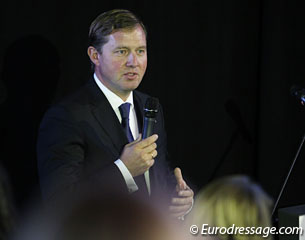 Sven Rothenberger started his speech humbly stating that "I am the ambassador for my wife. She does the work, does the daily work. She doesn't like to speak in public," said Rothenberger, who owns Gestut Erlenhof in Bad Homburg, Germany. "Why do we have success: children copy. They grew up amongst horses. They had a Dutch grandpa who had jumpers, a German grandpa who had race horses. We have a rule in the family and that is horsemanship. We give our horses a youth, a working phase and then a full retirement."
Sven Rothenberger started his speech humbly stating that "I am the ambassador for my wife. She does the work, does the daily work. She doesn't like to speak in public," said Rothenberger, who owns Gestut Erlenhof in Bad Homburg, Germany. "Why do we have success: children copy. They grew up amongst horses. They had a Dutch grandpa who had jumpers, a German grandpa who had race horses. We have a rule in the family and that is horsemanship. We give our horses a youth, a working phase and then a full retirement."
Sven explained how in the beginning, the kids had to observe and learn "We told them to sit in the corner, be quiet, not shout and watch mom and dad ride." For sure the difference with other talented children from horsey families, the Rothenberger kids always had exceptional horse quality to work with from the start. "They started with jumping ponies, but then they began to copy and to motivate them is to give them a chance to have success," said Sven. "Dressage is the school of life: you show respect to the horse and do the daily work."
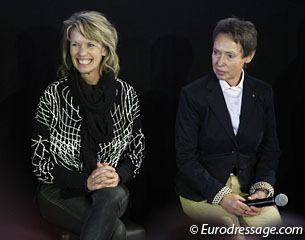 When asked if it was all smooth sailing along the years, Sven was frank enough to admit there have been a few bumps. "They do question and they do argue what the parents are doing on the horse," he said. "Gonnelien would get on the horse or pony and show it to the kids. Sometimes you can't explain it but have to show it. For instance, Sanneke loves that Sönke criticizes her. It gives her confidence." Sönke, who was this year a member of the German Olympic team at age 21, did go through a show jumping phase. "We make deals with the kids. Sonke said that he wanted to switch to show jumping tomorrow. We said no, the deal was to finish the pony season till September as we agreed with team trainer Connie Endres. He did that and then we supported him in show jumping. They could do any sport they wanted to do, as long as it had to do with horses," Sven quipped. Sönke's return to dressage came through his Olympic Cosmo who gave him the same great feeling as a show jumping horse did.
When asked if it was all smooth sailing along the years, Sven was frank enough to admit there have been a few bumps. "They do question and they do argue what the parents are doing on the horse," he said. "Gonnelien would get on the horse or pony and show it to the kids. Sometimes you can't explain it but have to show it. For instance, Sanneke loves that Sönke criticizes her. It gives her confidence." Sönke, who was this year a member of the German Olympic team at age 21, did go through a show jumping phase. "We make deals with the kids. Sonke said that he wanted to switch to show jumping tomorrow. We said no, the deal was to finish the pony season till September as we agreed with team trainer Connie Endres. He did that and then we supported him in show jumping. They could do any sport they wanted to do, as long as it had to do with horses," Sven quipped. Sönke's return to dressage came through his Olympic Cosmo who gave him the same great feeling as a show jumping horse did.
Van Grunsven concurred and said that her son, Yannick Janssen, has now taken up show jumping as well. "In Holland we have the Bixie Days, which is the starting shows for kids. The trainer can stay in the arena and afterwards the judge says how well they have brushed their pony, but that next time they need to ride their corners better," said Anky joyfully. Tineke Bartels, whose daughter Imke is also a Dutch Olympic dressage rider, added, "as a mom training your own child you have to train yourself to be a better coach."
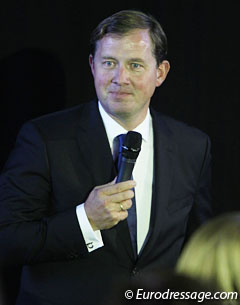 The Rothenberger kids are all known to have nerves of steel. "We do put pressure on them, but also take it back. If a test didn't work, we say 'no problem. it's just a horse'," said Sven. "Also, the kids have to be a bit further in their training at home than the level required at shows." Rothenberger is an adament believer in providing schoolmasters for young children, instead of letting them struggle on inexperienced young ponies and horses. "You learn cycling on an old bicycle," he said, adding that "something this expression is used in a funny way, but how to explain someone a feeling, they should feel it. They got it on experienced ponies and horses."
The Rothenberger kids are all known to have nerves of steel. "We do put pressure on them, but also take it back. If a test didn't work, we say 'no problem. it's just a horse'," said Sven. "Also, the kids have to be a bit further in their training at home than the level required at shows." Rothenberger is an adament believer in providing schoolmasters for young children, instead of letting them struggle on inexperienced young ponies and horses. "You learn cycling on an old bicycle," he said, adding that "something this expression is used in a funny way, but how to explain someone a feeling, they should feel it. They got it on experienced ponies and horses."
The first day of the Forum concluded with a stylish and lavish dinner at Kasselmann's Gestut Osthoff in Georgmarienshutten, Germany.
Text by Astrid Appels - Photos © Ruchel - Astrid Appels
Related Link
2016 Global Dressage Forum - Day One: Surprise FEI Revelations, Media and Sponsorship